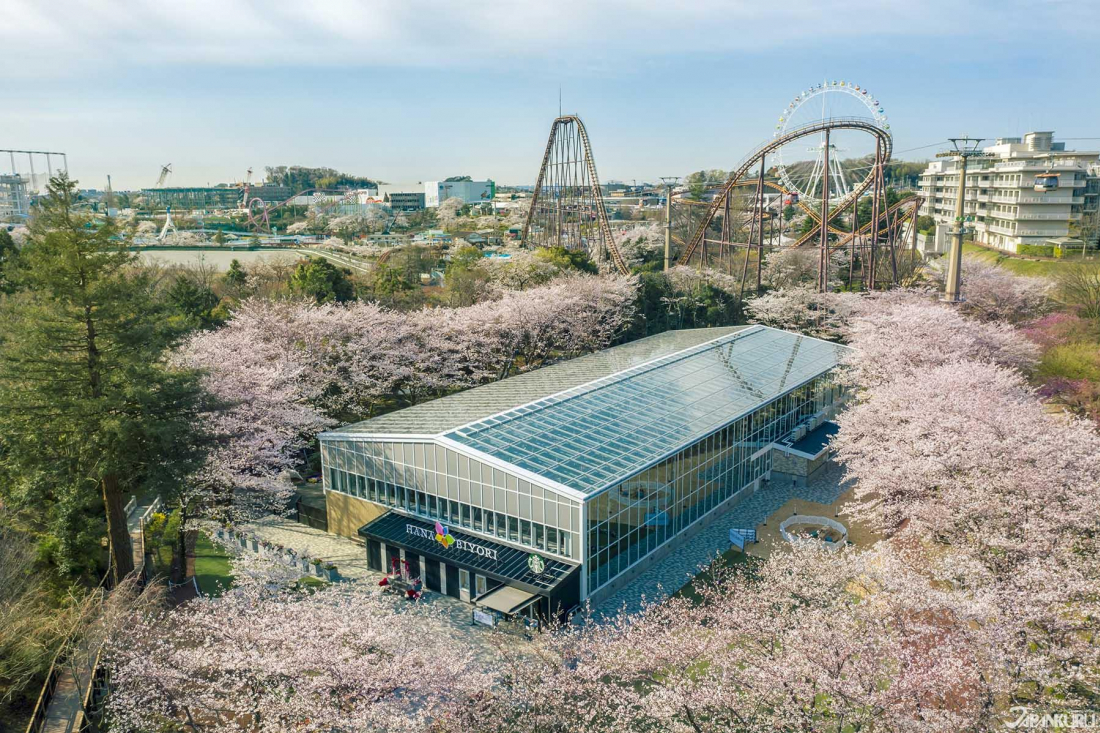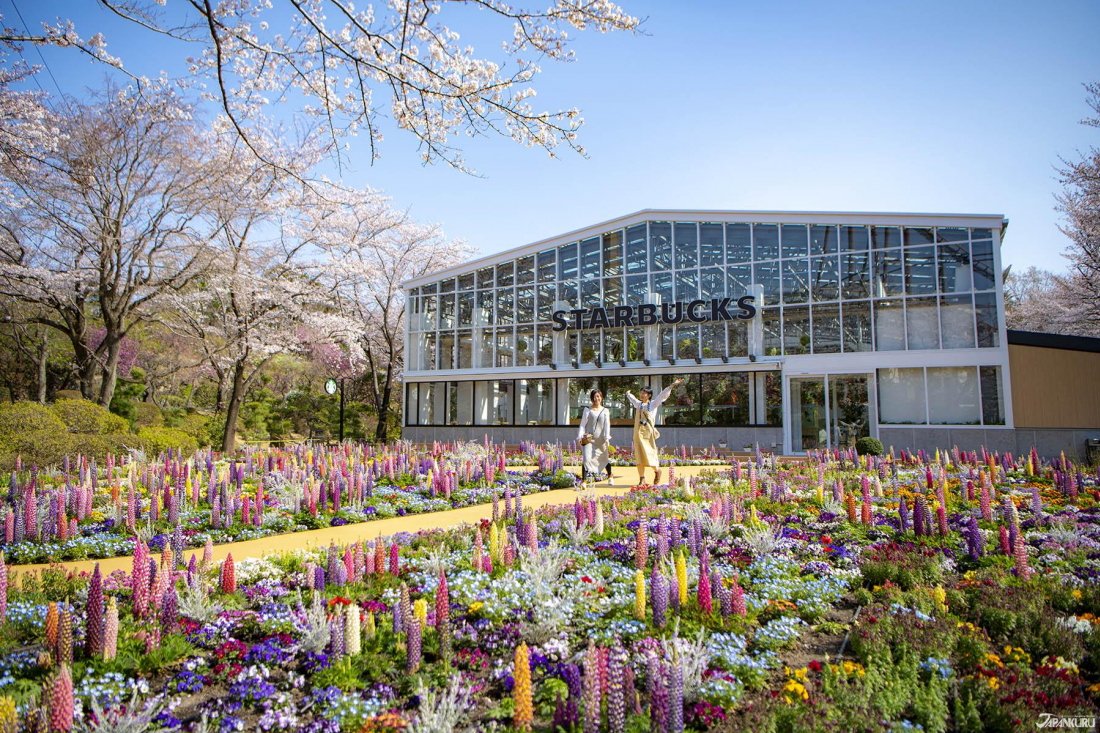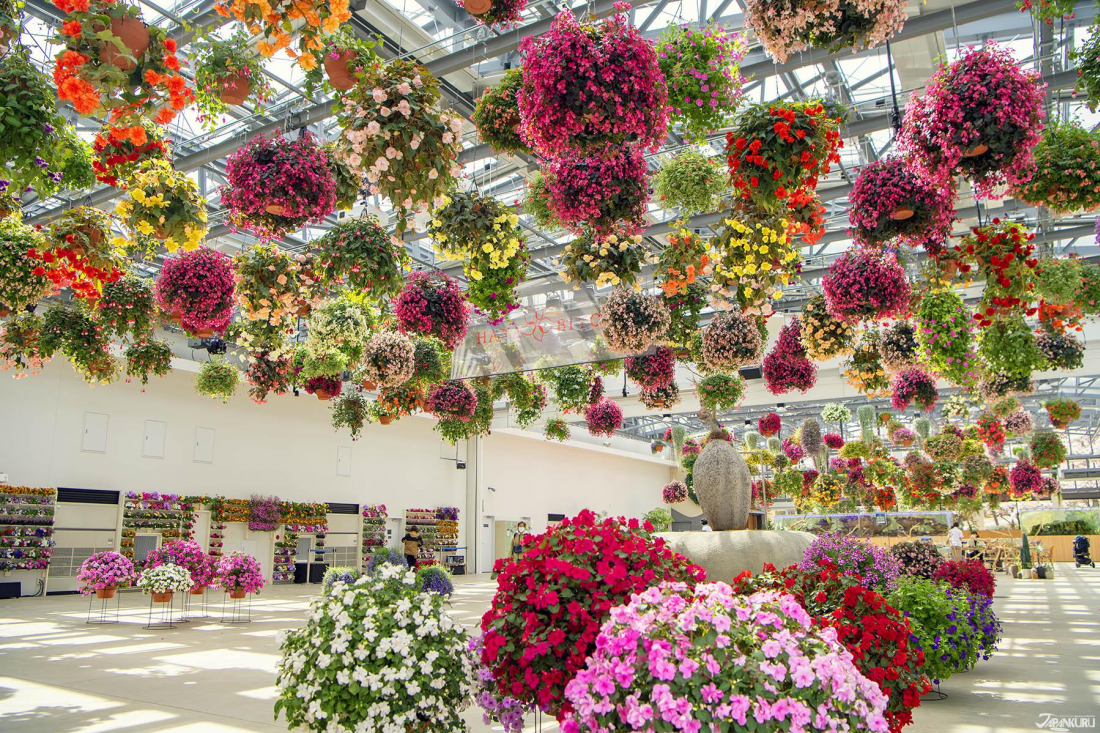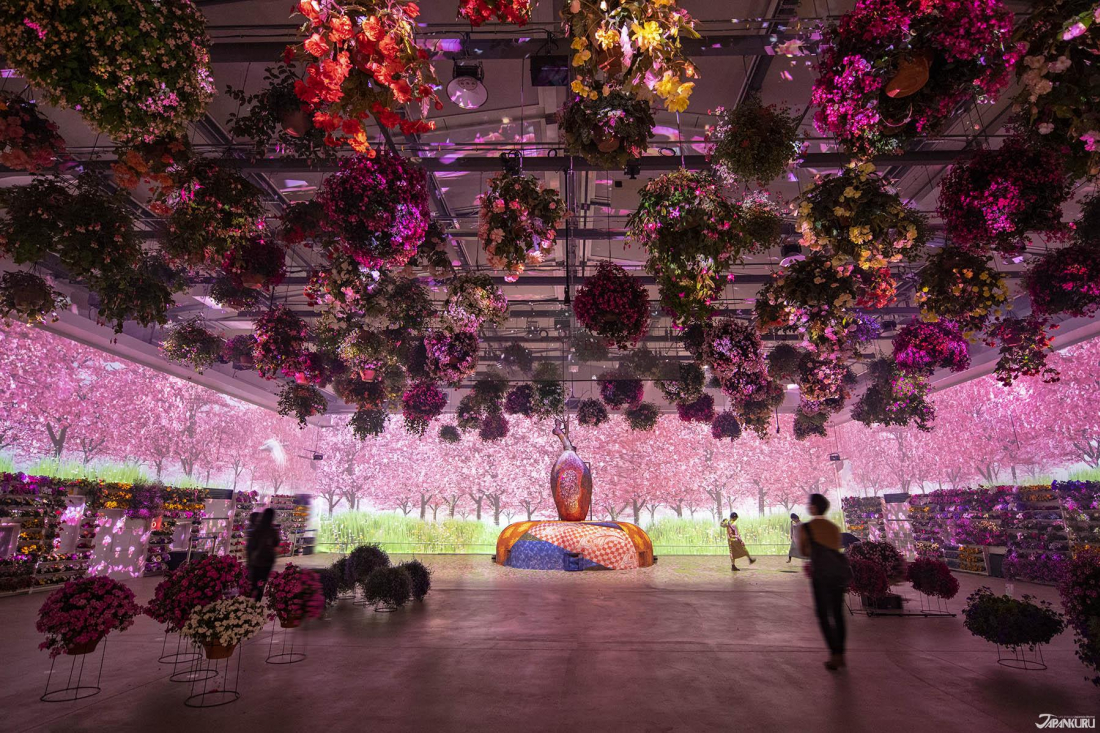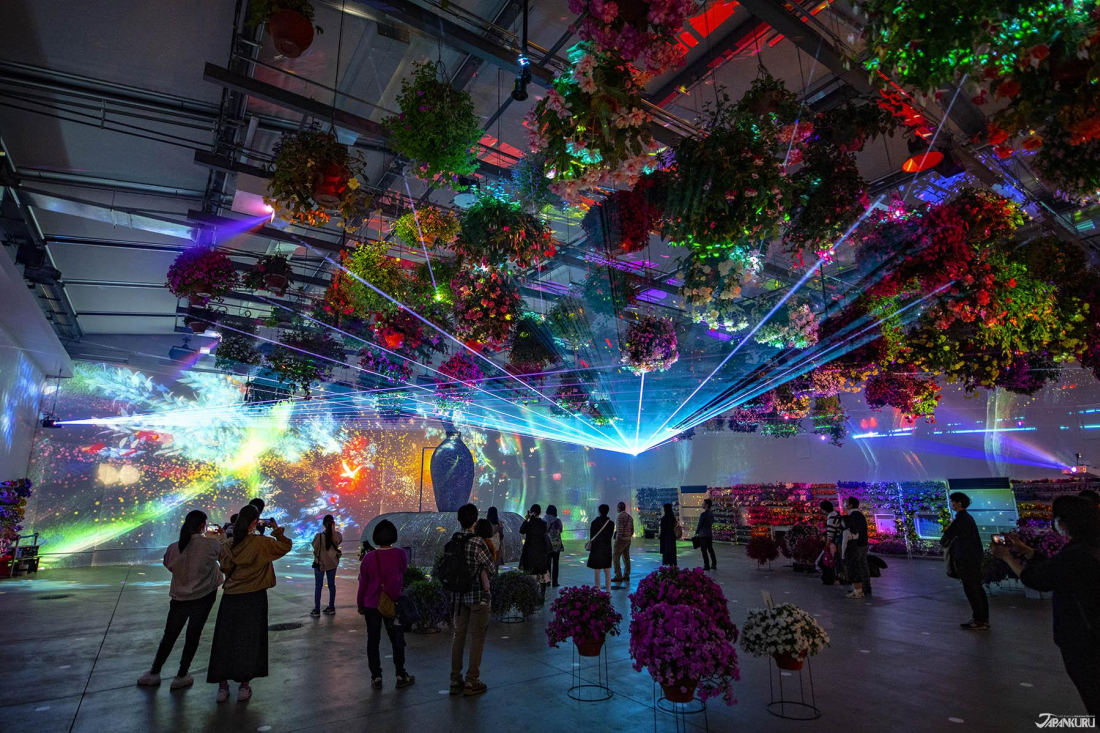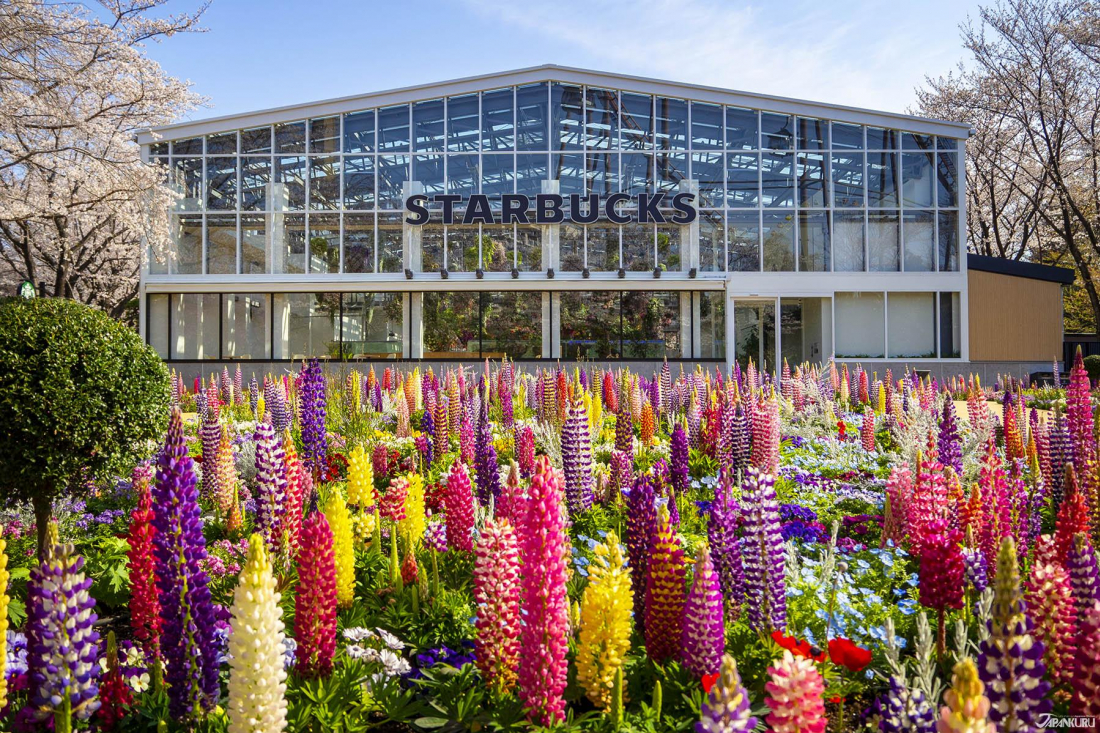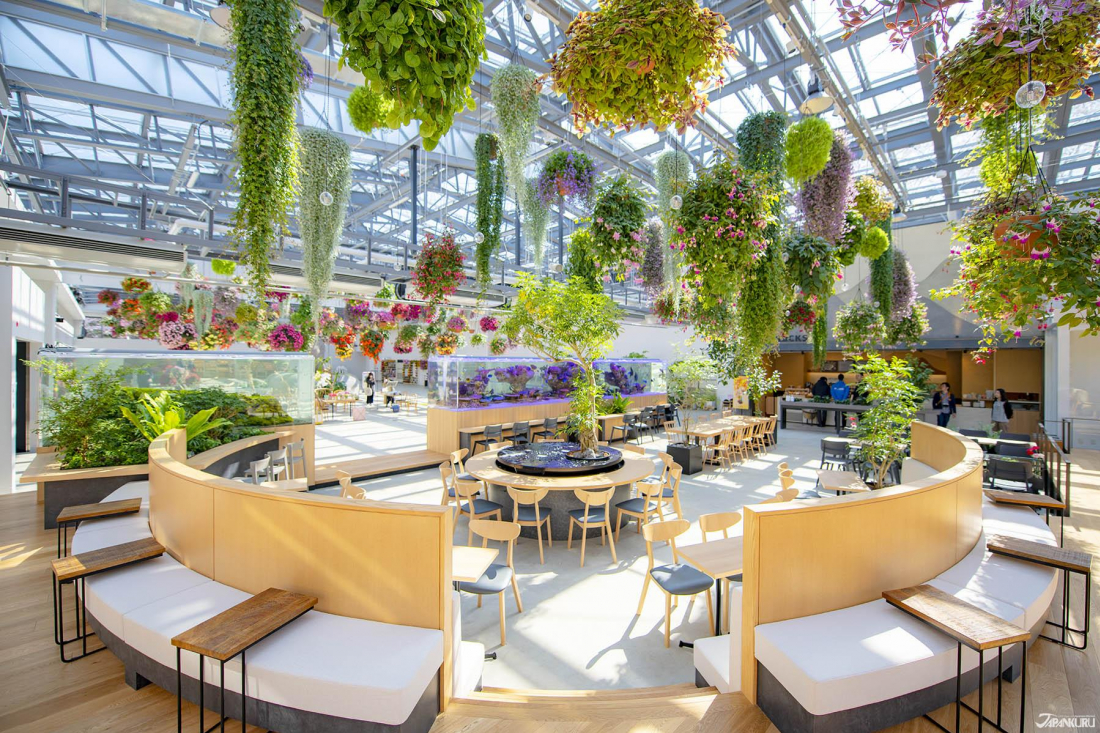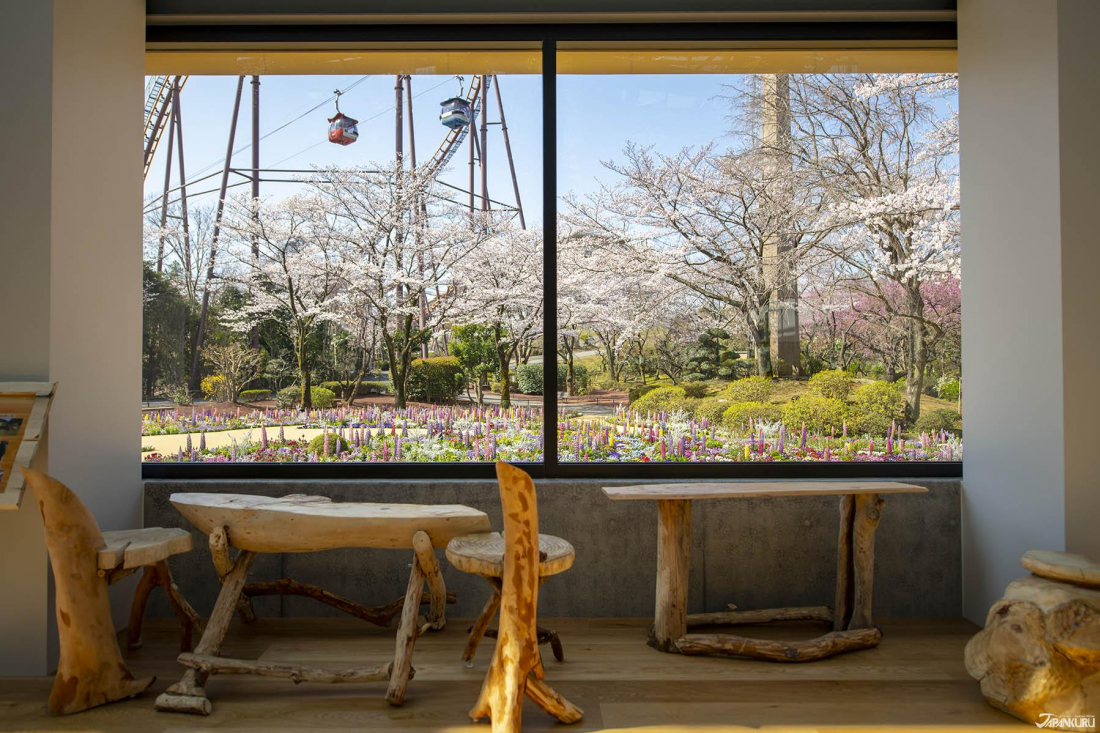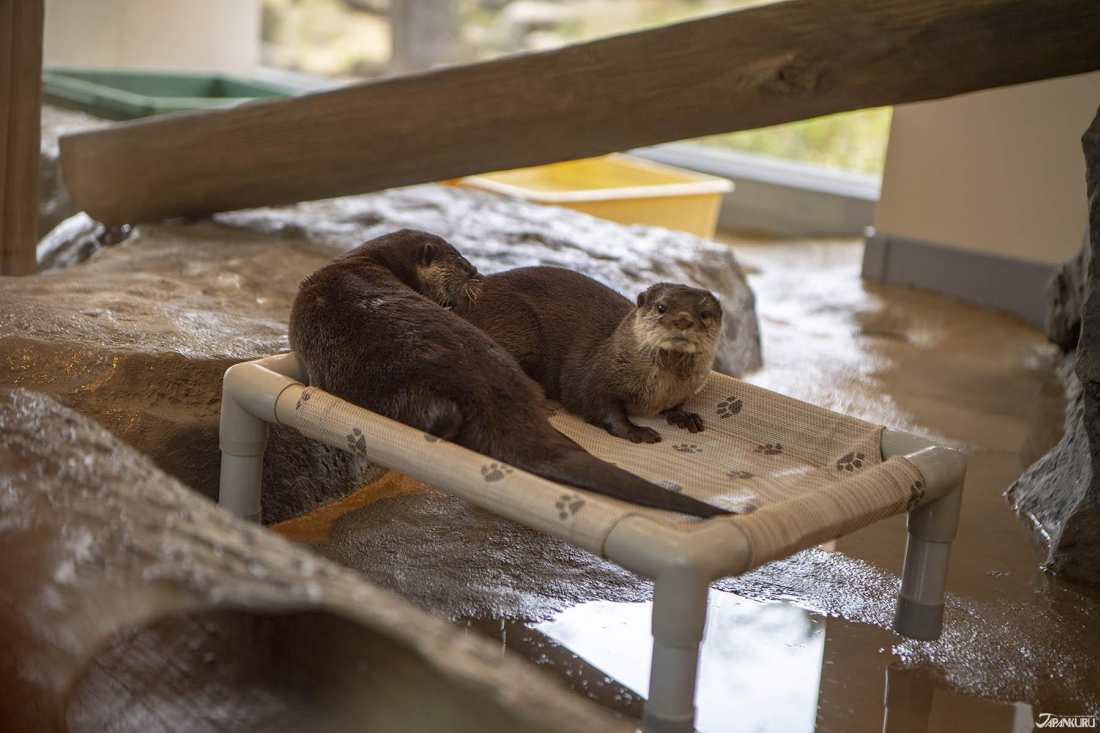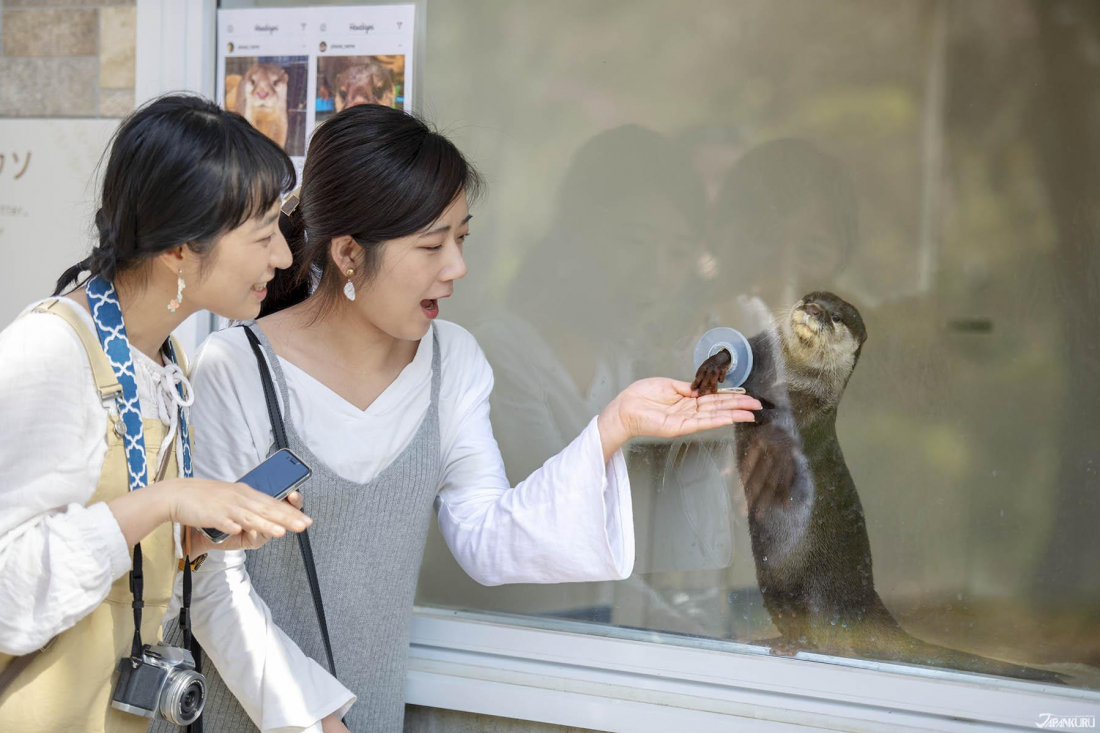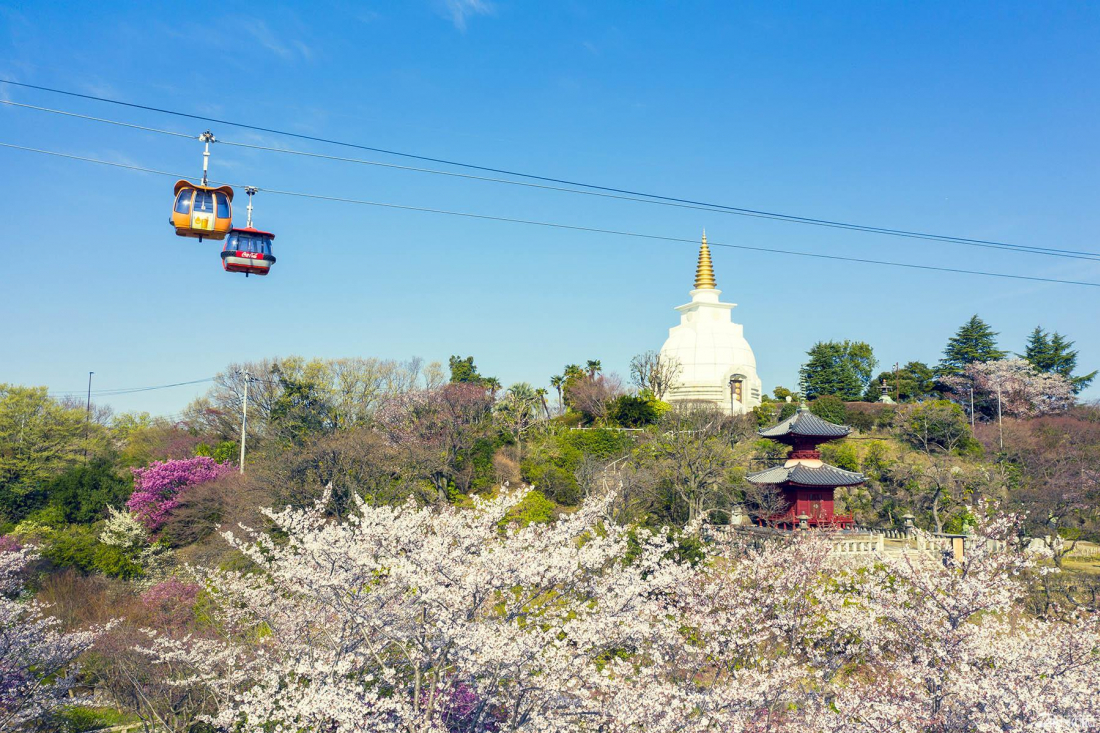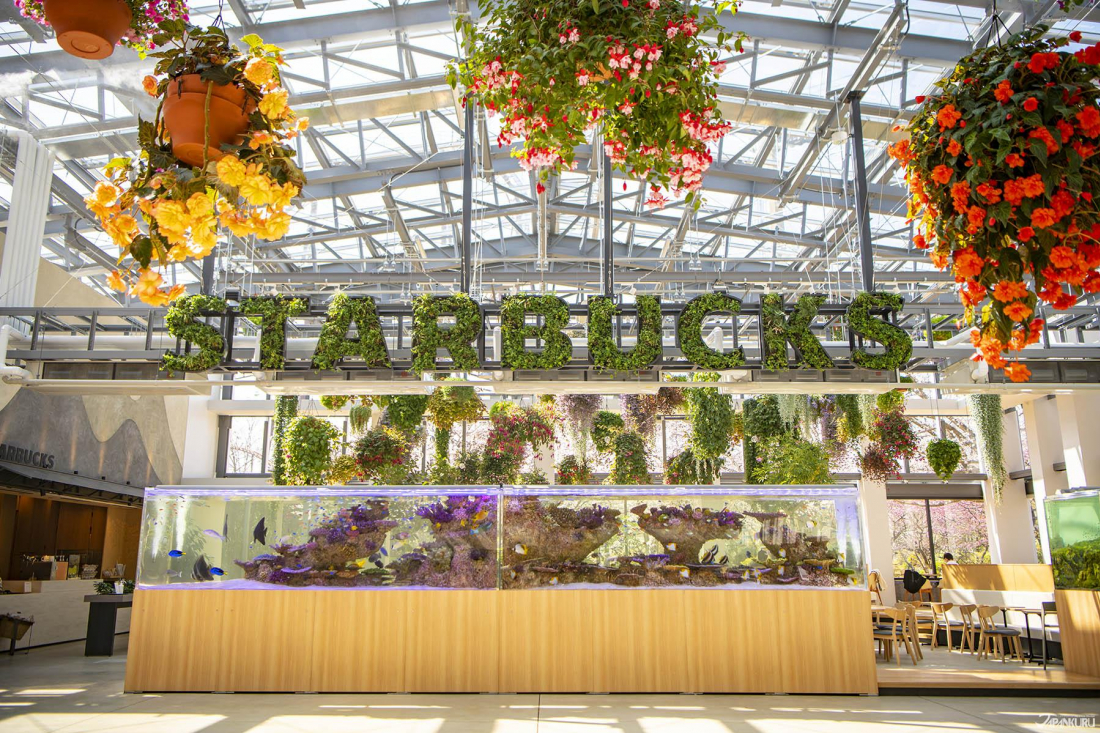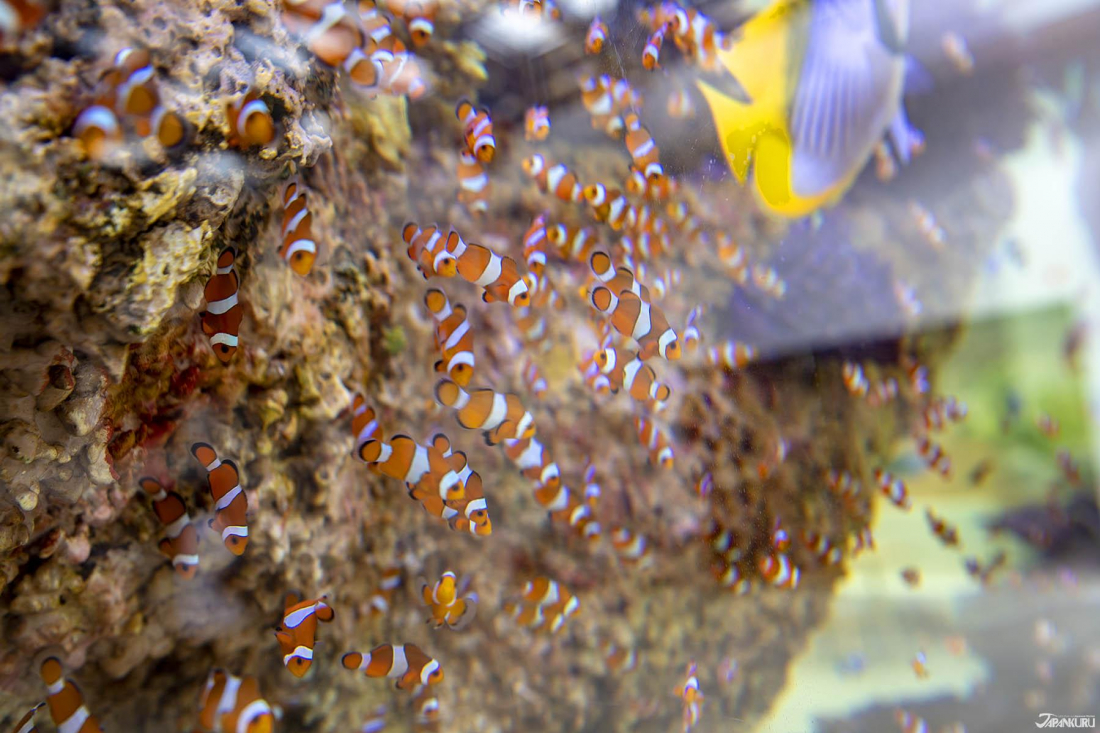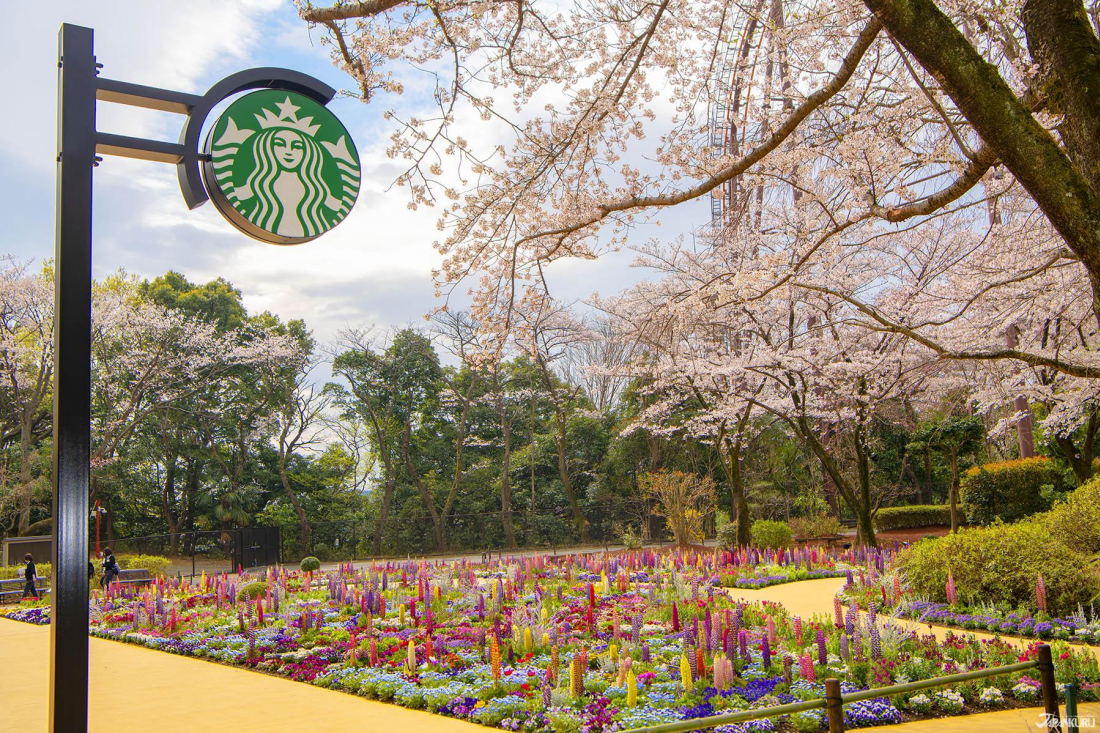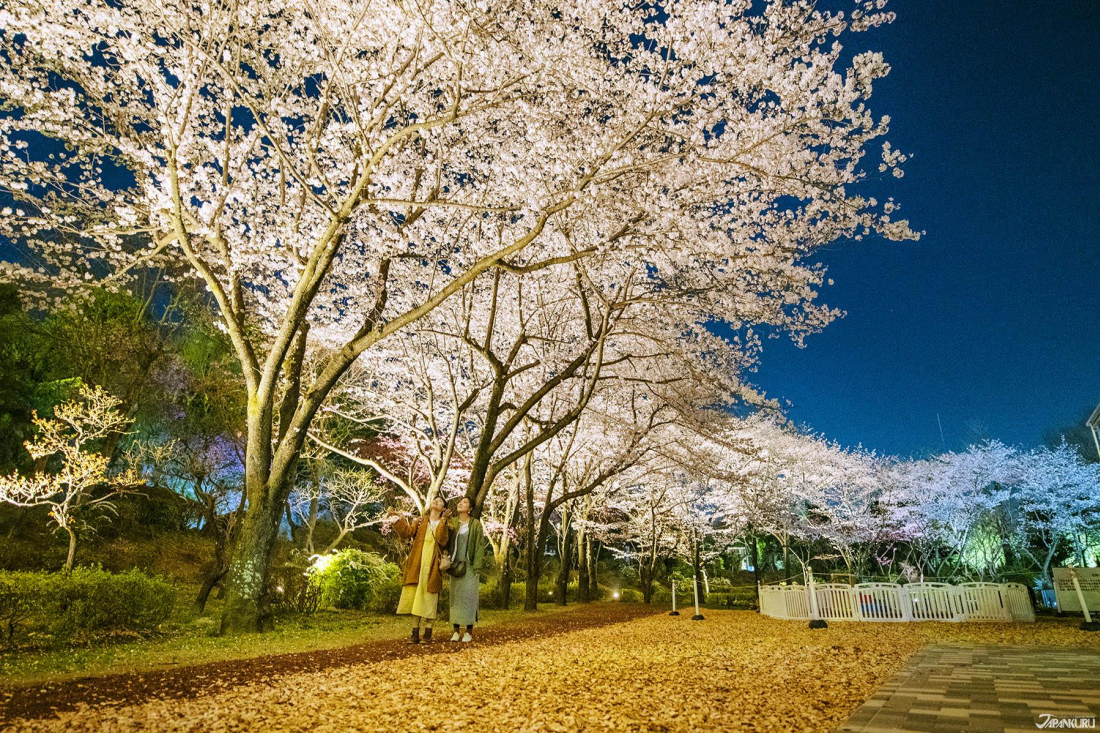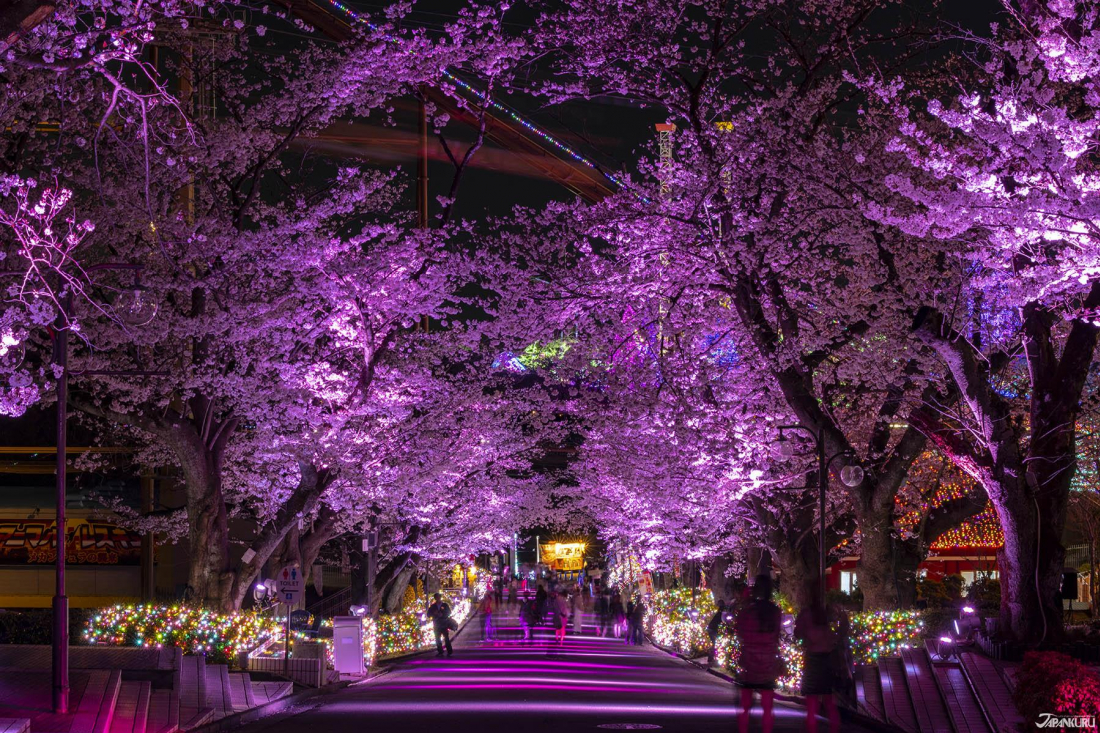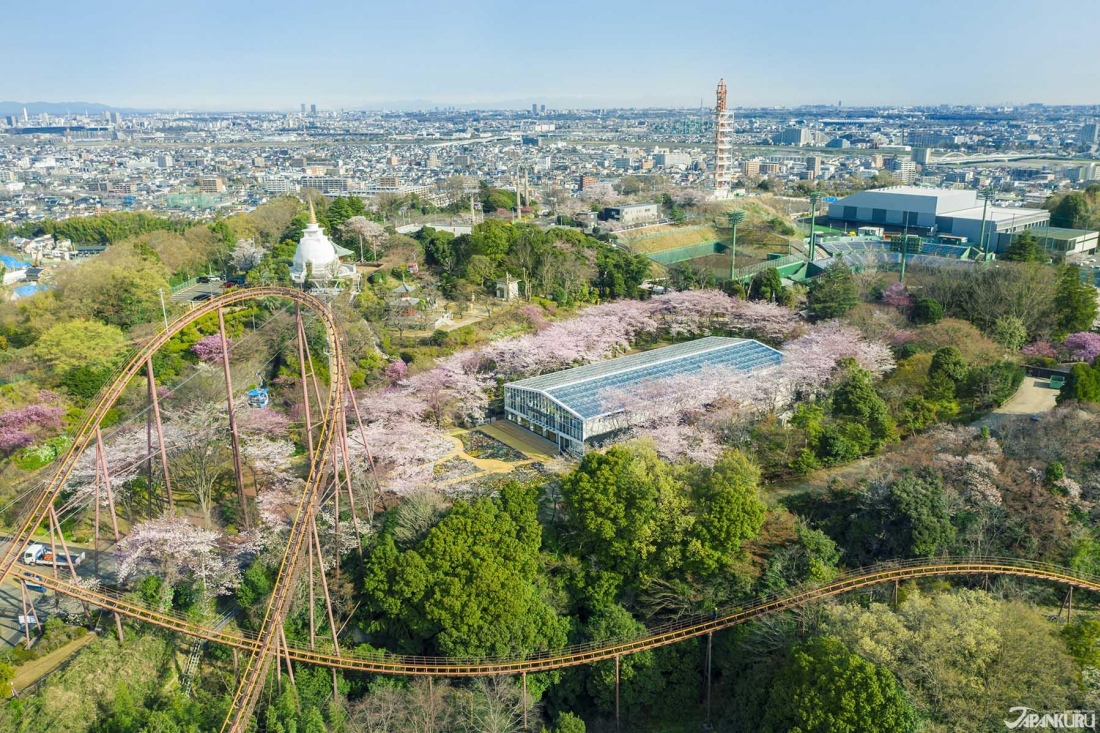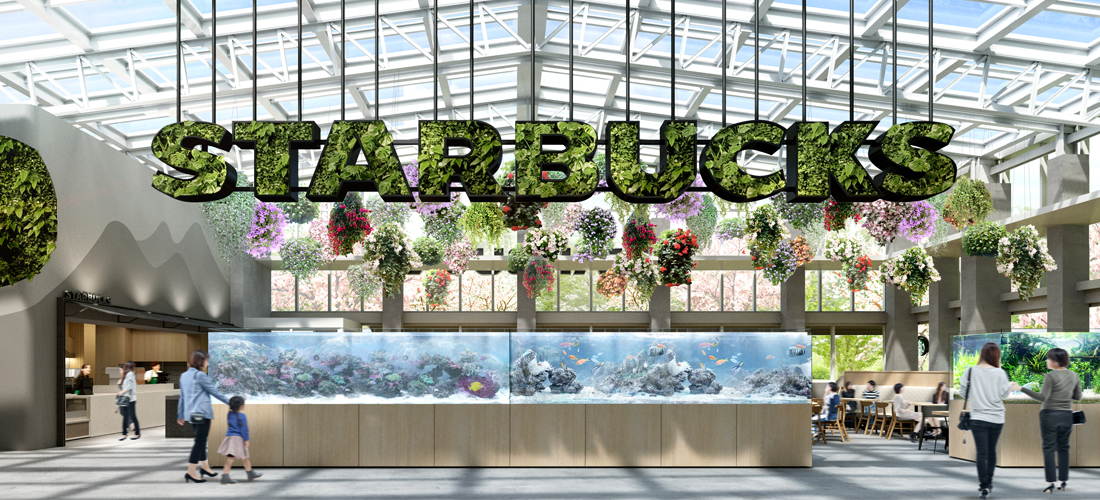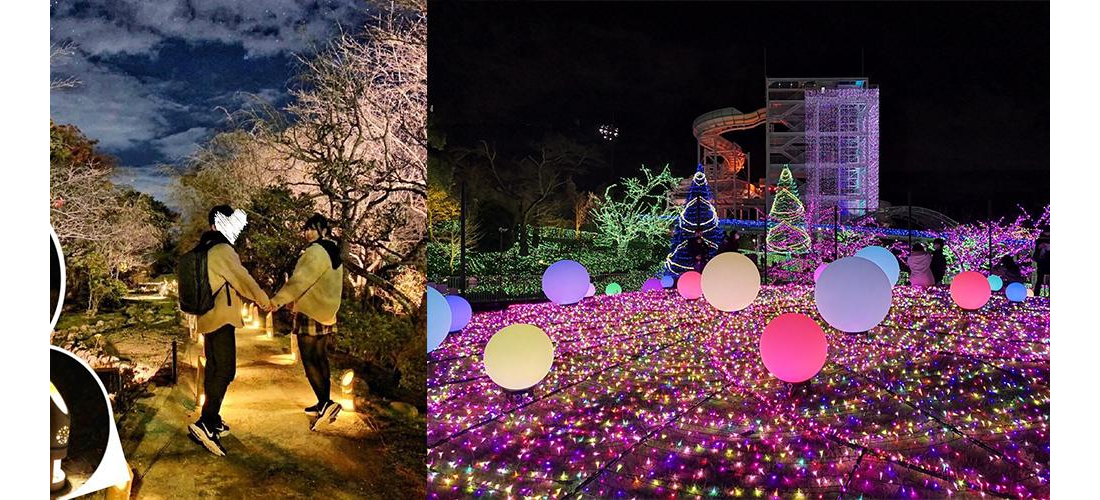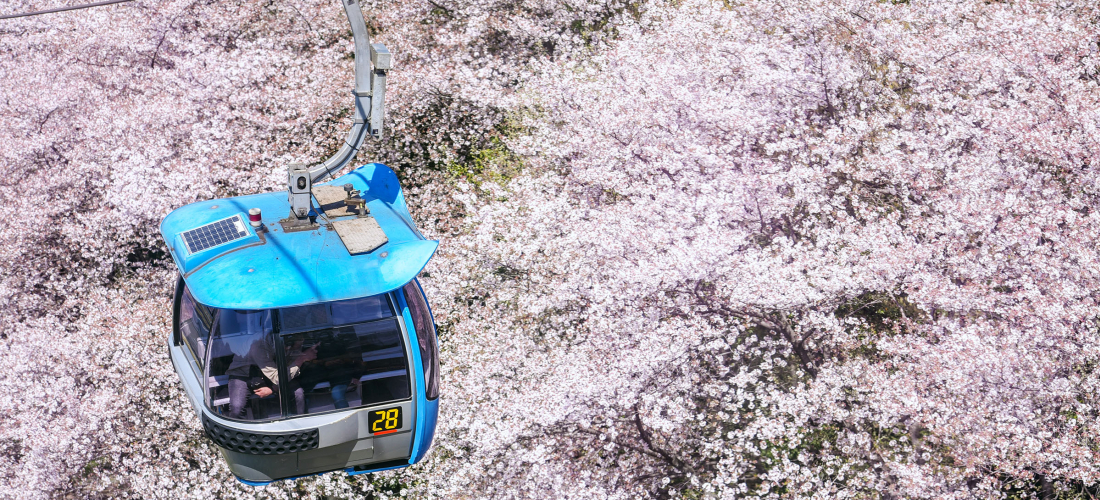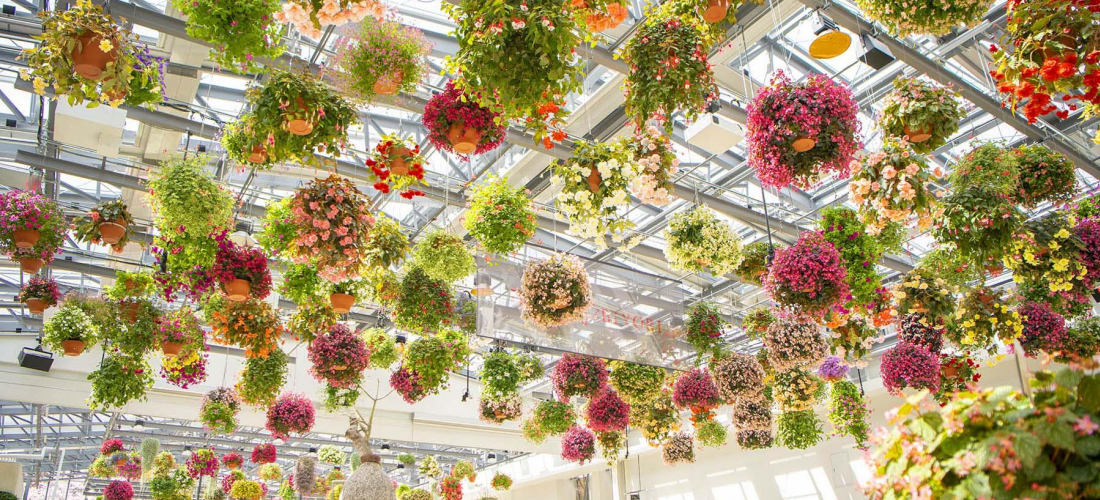
CONTENTS
Just outside of Tokyo, the new Hana-Biyori is a modern botanical garden within a famous Japanese amusement park.
Tokyo’s New Modern Take on the Botanical Garden
At Hana-Biyori, Digital Art Shows Meet Natural Flowers
Yomiuriland is a popular Tokyo amusement park, just outside the city and a straight shot from Shinjuku, and it's already known for seasonal attractions. The park fills with visitors who come to swim at their summer water park or see the winter holiday lights, and the profusion of cherry trees at Yomiuriland means it's already a popular destination for flower lovers. Coming off of their 70th anniversary celebrations in late 2019, the beloved Tokyo park is now opening a brand new area, with attractions a little different from their standard roller coasters and Ferris wheels.
Hana-Biyori is just the kind of botanical garden you'd expect from an amusement park. Thanks to some pretty spectacular digital art shows taking advantage of projection mapping technology, and flowers of all shapes, sizes, and colors decorating the area in numerous different ways, it's a very 2020 kind of botanical garden. Not only does Hana-Biyori add to the appeal of Yomiuriland as one of Tokyo's best cherry blossom viewing spots, but it's another step forward in the park's mission to become a "Super Amusement Park."
Many of the highlights of Hana-Biyori are inside the large greenhouse-style building, but before even stepping inside visitors are surrounded by blossoms. Of course, the facility has different flowers blooming year-round, but a springtime trip will mean pink cherry blossoms in every direction, and a rainbow of colorful blooms in the soil below. The water that keeps this garden alive and flows through the ponds and streams comes from the surrounding Tama Hills, and the park operators are clearly conscientious about maintaining this local resource as it cycles through Hana-Biyori.
The view from below the trees shows off the vibrant colors of the plants blooming in the gardens next to Hana-Biyori Hall, especially with the sun shining on them and sprays of cherry blossoms swaying in the wind off in the background. Join the Japankuru team as we explore some of the best parts of the Hana-Biyori gardens and the indoor highlights!
4015-1 Yanokuchi, Inagi, Tokyo
Hours: 9:30 – 17:00
(Hours subject to change, check here for details and closure dates.)
Access: Free Shuttle Bus from Keio Yomiuri-land Station
Admission: Adults 1,200 yen / Children 600 yen
(Discounted Hana-Biyori tickets available with the purchase of a Yomiuriland Amusement Park ticket.)
Official Website (en)
6 Hana-Biyori Highlights
① Perhaps Japan’s Largest \”Floral Chandelier\” of Hanging Flowers
This huge structure on the ceiling of the Hana-Biyori building is a shock of colorful blooms, with 300 different kinds of flowers hanging in baskets, including fuchsias, petunias, geraniums, and saxorums (cape primroses). While it can be hard to measure a ceiling full of flowers, the so-called "floral chandelier" at Hana-Biyori is easily one of the largest in Japan. With the sun shining through the glass roof, the flowers and their green leaves look especially vivid, and the plants cast intricate shadows on the floor, shapes changing as the room's airflow gently rocks the hanging tendrils.
② A Digital Art Show Combining Real Flowers and Projection Mapping Technology
If you're exploring the Hana-Biyori Hall and you see a screen start to cover the glass ceiling and block out the sunlight, don't worry, that just means a Hana-Biyori projection mapping show is about to begin! A curtain lowers in the middle of the hall, creating an enclosed show space with a three-sided projection screen 60m (almost 200ft) long. With the lights dimmed, the projection mapping begins, creating an immersive world of flowers making full use of the screens, the floor, the floral chandelier, and the flower structures dotting the new "stage."
Together, the 20 high-brightness projectors and immersive 14.2 surround sound audio really turn the hall into a world of flowers for the 10-minute show. Branching out from a real 400-year-old palo borracho tree that lives in the center of the hall, a symbol of Hana-Biyori at the center of the show, flowers shoot across the walls and dance along the floors as you watch.
To ensure a spectacular finale every time, the show has a unique multi-ending approach. During each showing, the ending is chosen by analyzing the audience's emotions as they watch! Every member of the audience can influence the show and participate just a little, just by observing.
The show happens four times a day every weekday, and six times a day on weekends and holidays, and show times change from season to season. No additional tickets are necessary—you can just check the day's schedule and make your way to Hana-Biyori Hall before the show begins.
Digital Art Show
Weekday Schedule: 10:30, 12:30, 14:30, 16:30, 18:00*, 19:30*
Weekend Schedule: 10:00, 11:00, 13:00, 14:00, 15:00, 16:00, 17:30*, 18:30*, 19:30*
*Nighttime shows only from March 27th to April 5th.
③ Japan’s First Botanical Garden Starbucks
Before its opening, Hana-Biyori drew a lot of attention thanks to the plan to include a Starbucks coffee shop inside the flower-focused facility. Japan is already known for being the home of some of the world's most amazing Starbucks locations, including the "Reserve Roastery" in Nakameguro, Tokyo, one with impressive Kengo Kuma architecture next to Dazaifu Tenmangu Shrine in Fukuoka, and one built inside a traditional Kyoto building near Kiyomizudera Temple. Now that it's open for business, the Hana-Biyori Starbucks is clearly joining the ranks as one of Japan's most visually appealing and fun-to-visit locations.
The Starbucks takes up a large chunk of Hana-Biyori Hall, facing the glass wall on one end of the building. A portion of the seating is handmade by local artisans, using timber from typhoon-damaged trees once growing on Yomiuriland facilities. Each chair and table was made as a unique piece, taking into account the natural shapes of the wood and utilizing them to create furniture that's both attractive and functional. Take a seat in one of the handmade chairs and you can look out onto a colorful garden area full of flowers so colorful they're almost neon.
With the wooden furniture, the flowers outside and inside, and the airy spaces, it's certainly a beautiful coffee shop. When we visited, we were tempted to order second and third rounds of coffee, just so we could spend the day admiring the flowers with the dappled sun filtering in.
Starbucks, Yomiuriland Hana-Biyori Location
Hours: 9:30 – 17:00
Official Page (en)
④ Otter Feeding Experiences
The palo borracho tree is a symbol of Hana-Biyori, and the theme of the whole area is the flowers, but if you're looking for a Hana-Biyori mascot, it has to be the facility's adorable Asian small-clawed otters. Tucked away in one side of Hana-Biyori Hall is an otter enclosure, where you can look into the windows throughout the day and see the little family of four, frolicking in and out of the water.
Even better, Hana-Biyori is planning daily opportunities for visitors to interact with the otters and get a moment of one-on-one otter time. Every day they open a tiny window in the enclosure, just big enough for a little otter hand to reach through, and let people put the snacks directly into their paws. Just look at that otter reaching out its fingers for a tasty treat—how could we resist?
Otter Feeding Experience
Schedule: 11:30, 13:30, 15:30
Location: "Otter Biyori" Otter Enclosure
※ Suspended at time of publication in line with COVID-19 infection prevention policies.
⑤ Gardens Full of Japanese Cultural Properties, Fall Leaves, and Spider Lilies
Hana-Biyori isn't limited to the main building; the grounds contain a variety of areas featuring different themes, including some perfect for the Japanese tradition of "koyo" (紅葉/fall foliage viewing), and some with traditional Japanese architecture. One part is called the Sacred Forest, so named because of the collection of historic buildings within, some of which have been designated official Important Cultural Properties of Japan.
A pagoda holding relics of Buddha and historic statues of Myoken Bodhisattva and Sacred Avalokitesvara are just some of the pieces of Japanese history hidden among the gardens, and springing up around these structures every autumn are more than 2,000 red spider lilies.
⑥ Okinawa-Style Tropical Fishtanks
Separating the Starbucks from the rest of Hana-Biyori Hall is a bank of saltwater fishtanks. The colorful tropical fish really compliment the hanging flowers, all uniquely colorful living gems. While we can all enjoy the gorgeous flowers found in every direction at Hana-Biyori, younger visitors are bound to choose a Starbucks table seated up against the aquariums.
Imported from South Korea, the large main tank is 8m (26ft) long and filled with 1,200 clownfish, blue-green damselfish, sea goldies, and other tropical beauties, about 50 species all swimming around a little coral reef.
Fun Add-Ons
Botanical Garden Souvenirs
The Hana-Biyori giftshop is a small area filled with an impressive variety of gifts to take home, and while plenty of those are focused on the Hana-Biyori flowers, we don't think anybody's complaining about the prevalence of the otter mascots! Alongside a wide selection of otter toys, there are some surprisingly sophisticated flower/otter items that combine cute characters with elegant illustrations in a way that seemed thoroughly Japanese.
For an even more one-of-a-kind souvenir, Hana-Biyori also sets up flower and plant-related workshops every day, like flower arrangement or moss terrariums. (Details on the official website here.)
Sakura! Hanami! Cherry Blossom Viewing!
We already mentioned that the cherry blossoms (AKA sakura, 桜) of Yomiuriland are famous, and the new swath of cherry trees at Hana-Biyori makes it an even better spring destination. The Japanese tradition of hanami (花見), or cherry blossom viewing, is a long-lived custom where friends and family go out to admire the flowers together, drinking and eating in the shade of the cherry trees. At Hana-Biyori, gathering with friends for a drink at Starbucks and strolling along the sakura-lined paths is a fun new way to participate!
During sakura season, Hana-Biyori also extends its hours for night-time cherry blossom viewing. The brightly lit pink flowers against the dark sky make for a totally different experience. We feel pretty sure that this will become a go-to date activity in coming years.
Make It a Full Day Out
Have You Been to Yomiuriland Yet?
Hana-Biyori is a part of Yomiuriland, but they are distinct areas with separate entrances, and tickets can be purchased separately. If you're just interested in grabbing a drink at the Starbucks and taking a walk among the flowers before heading home, the separate tickets make it easier to do just that, but we recommend you make a day of it. Buying both tickets will get you a 200~300 yen discount, and will give you full access to all the flowers of Hana-Biyori, and the popular roller coasters and attractions of Yomiuriland Amusement Park. It's enough to entertain just about any traveler for a day!
When the Japankuru team visited Hana-Biyori during its very first days open, spring cherry blossoms were in full bloom, so we had a chance to see the flowers all over the two areas. During the morning, we loved looking at the lively scenery of the Yomiuriland gondola gliding over the trees and rollercoasters whipping past pink petals. Once the sun set, the romantic lighting and music of Hana-Biyori made it a dreamy escape. If possible, we recommend you check out both!
Hana-Biyori Is a New Go-To Excursion Out of Central Tokyo
During our first tour of Hana-Biyori, we were blown away by colorful flowers growing from the ground and hanging down from the ceiling, and totally entertained by the adorable otters and digital art shows. Of course, the Starbucks fans on our team seemed happy to sit with their drinks and look out the window all day! So if you're looking for a day away from bustling downtown Tokyo, alongside popular day trip destinations like Yokohama and Kawasaki, think about heading to Yomiuriland and Hana-Biyori!
Details
NAME:Hana-Biyori (at Yomiuriland Amusement Park)
MAP
ACCESS:Free Shuttle Bus from Keio Yomiuri-land Station
PROFILE
Follow us @Japankuru on Facebook, Instagram, and Twitter!
COMMENT
FEATURED MEDIA
VIEW MORE
・Accommodations for Odaiba Sightseers: Mitsui Garden Hotel Toyosu PREMIER ・住宿推薦 三井花園飯店 豐洲普米爾 ・오다이바 관광 맞춤 숙소: 미츠이 가든 호텔 토요스 프리미어 ・ค้างคืนที่ Mitsui Garden Hotel Toyosu Premier โรงแรมสำหรับผู้มาเยือน Odaiba #japankuru #odaiba #tokyo #tokyotrip #japantrip #japantravel #mitsuigardenhotel #mitsuigardenhoteltoyosupremier #tokyohotel #odaibahotel #toyosu #tokyoview #tokyobay #rainbowbridge #미츠이가든호텔토요스프리미어 #오다이바 #오다이바맛집 #오다이바건담 #오다이바해변공원 #오다이바야경 #오다이바온천

Nagano Prefecture is famous for delicious soba noodles, and in the city of Ueda, you can learn from the experts! Local aunties run this cooking class, teaching you everything you need to know to make your own delicious plate of soba noodles entirely from scratch. #japankuru #soba #sobanoodles #japanesefood #travelexperience #japan #japantrip #ueda #nagano #japaneseculture #japanexperience #daytrip #daytour #cookingclass #japanesecookingclass #上田市 #そば作り #소바체험 #우에다시 #나가노여행 #일본소바

Kuramae Shrine is known for its early-blooming cherry blossoms and its gorgeous golden mimosa blooms, making it a great sakura spot for travelers arriving in Tokyo a little early for the main cherry blossom season. It’s also tucked away in a neighborhood packed with trendy cafes and coffee shops. Kuramae is a lovely place to spend the day. 🌸☕️ ・ #japankuru #kuramaeshrine #kuramae #tokyo #tokyotrip #cherryblossom #cherryblossoms #mimosa #tokyocherry #花見 #蔵前神社 #ミモザ #桜 #東京 #Japan #日本 #일본 #Japon #ญี่ปุ่น #Japão #Japón #япония #japantravel #日本旅行 #日本旅遊 #일본여행 #japan_of_insta #japantrip #traveljapan

Local Japanese Favorites at the Okinawa Don Quijote ② Ohta’s Isan, the digestive aid of the Japanese people ・ ・ 2024唐吉訶德不可不知的好物推薦② 日本國民消化小幫手:太田胃散 ・ ・ 오키나와 돈키호테 숨은 꿀템2. 일본 국민 소화제! 오타이산 #japankuru #okinawa #donki #沖縄 #오키나와 #오키나와여행 #오키나와돈키호테 #일본쇼핑리스트 #오타이산 #일본소화제 #太田胃酸 #ohtasisan

Happy Valentine's Day from the Japankuru team! May your day be full of sweet chocolates and sweet nothings. 💕 Or, if you're like a rising number of women in Japan, take the opportunity to treat yourself! 🍫💝💆 • Find out more at Japankuru.com! (Link in bio.) • #japankuru #valentinesday #valentineschocolate #japanesechocolate #japaneseculture #バレンタイン #バレンタインチョコ #メリーチョコレート #Japan #日本 #일본 #Japon #ญี่ปุ่น #Japão #япония #japantravel #日本旅行 #日本旅遊 #일본여행 #japan_of_insta #japantrip #traveljapan #japan🇯🇵 #japanlife #igerstokyo #explorejapan #japanfocus #enjoyjapan #japantravelphoto

Japankuru Coupon: BEAMS fashion, accessories, lifestyle goods, and more! BEAMS 5% Discount Coupon ▶︎ Validity Dates: February 1 ~ February 29, 2024 ▶︎ Discount: 5% off all products in-store ▶︎ Usable At: BEAMS stores throughout Japan (all stores except BEAMS JAPAN Izumo and BEAMS JAPAN Nikko) ▶︎ Details: Please present this coupon page before payment to receive your discount! This coupon is also valid in combination with tax-free discounts/refunds for foreign tourists. (Tax-free shopping is only available at some BEAMS locations.) Some products may not be eligible for discount. ・ ・ ・ BEAMS - JAPANKURU優惠折扣券 BEAMS 2024年2月限定特別優惠券 店內全部商品95折 ▶︎使用期間:2024/2/1到2024/2/29 ▶︎使用範圍:日本全國店舖 ▶︎使用方法:結帳時請務必事先向店員出示本優惠券,若未出示本優惠券恕無法享有本優惠。本優惠券可搭配免稅優惠一併使用,但不排除特定門市無法使用本優惠券。此外,不排除特定商品不適用本優惠券。 ・ ・ ・ 「빔즈(BEAMS) x 재팬쿠루(JAPANKURU)」스페셜 할인 쿠폰 빔즈(BEAMS) 5% 할인 쿠폰 ▶유효기간: 2024년 2월 1일 ~ 2월 29일(한 달 동안) ▶︎할인율: 매장 내 전 상품 “5% 할인" ▶︎해당 매장: 일본 전국 빔즈 (BEAMS) 매장 (BEAMS JAPAN이즈모、BEAMS JAPAN닛코는 쿠폰 할인 대상 제외 점포입니다) ▶︎상세 내용: 결제 전 본 쿠폰 페이지를 제시하면 정가대비 5% 할인된 금액에 구매하실 수 있습니다! 본 쿠폰은 외국인 관광객들을 대상으로 하고 있으므로 면세 혜택(빔즈 일부 매장)과 별도로 추가 할인이 가능합니다. (일부 매장 및 제품은 대상에서 제외될 수 있습니다.) #japankuru #beams #beamsjapan #beamsginza #coupon #재팬쿠루 #빔즈재팬 #빔즈 #일본여행 #일본쇼핑 #일본쇼핑리스트 #銀座 #東京 #tokyoshopping #japankurucoupon

